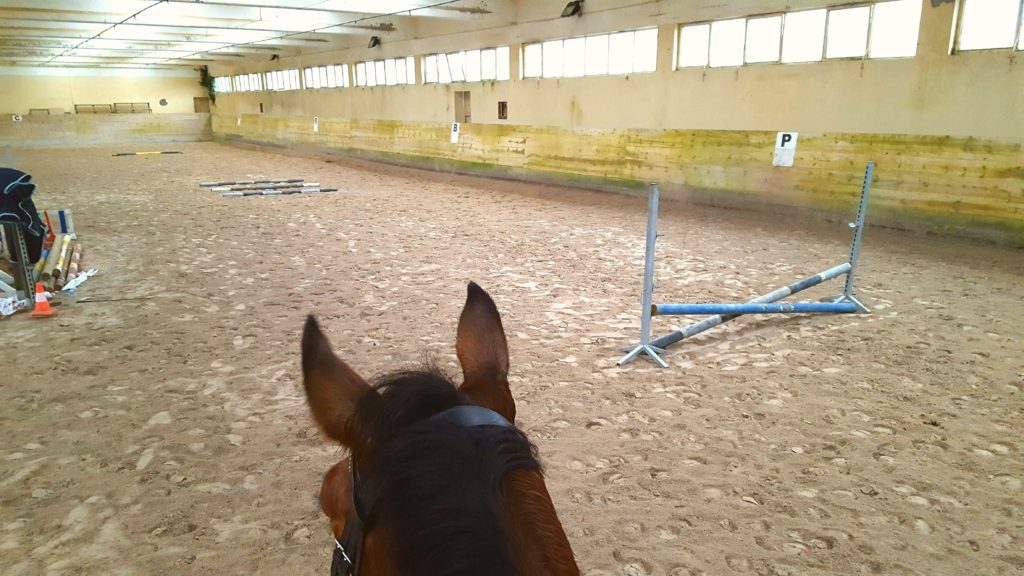Using Props to Improve Movement – Part 2 BY ALJA KISILAK
Continued from Part 1
GROUND POLES AND CAVALLETTI FOR BETTER BIOMECHANICS
While letters and cones are very effective for improving the rider’s navigation skills, ground poles and cavalletti improve the horse’s coordination and movement. When the horse moves over the ground pole, his attention is focused on the object beneath him, which automatically makes him lower his head and lengthen his neck as the muscles under the base of his neck become activated.
SOME BASIC GUIDELINES FOR USING GROUND POLES
In addition to being a great biomechanical tool, ground poles and cavalletti are a great way of breaking the routine and enriching the work. Poles can be used individually or in succession, raised or lowered, we can use them to make different shapes, like fans and labyrinths. We can ride between them or over them, depending on what the objective of the training is. When the poles are raised to about 30 cm or more off the ground, they are called cavalletti. We can use those to improve the quality of the canter, develop suppleness, strength and endurance. If we want to develop our horse’s body evenly and make him braver and more confident, we need to follow these basic rules that apply to ground poles, cavalletti and higher jumps:
- Always approach the obstacle in a straight line and continue in a straight line afterwards. The exception are exercises performed on a circle.
- Approach the obstacle perpendicular to it.
- When approaching the obstacle, aim for the middle of it.
As we advance in our training, we can approach the obstacles at an angle or from a turn, but we should only do that if we know exactly what the purpose of it is.

Incorporate poles and cavalletti in your horse’s training on a weekly base. It improves horse’s biomechanics, riders’ orientation and it is fun for both. We use poles to improve movement patterns and equalize asymmetries due to inappropriate training or riding, injury or other issues. There are some contraindications in using ground poles and cavalletti that we should take into account while planning the training.Poles should be introduced to the horse gradually and systematically, so we gradually build good coordination, balance, strength, stamina and trust. In this way a good base for higher jumps is set successfully.
DON’T DISTURB THE HORSE!
The role of the rider during work over ground poles is to guide the horse toward the obstacle, tell him what gait or tempo to tackle the obstacle in and where to go afterwards. The movement across the obstacle is the horse’s responsibility. The rider must not disturb him by losing balance or by trying to micromanage the movement. This is why it is very important for the rider to learn how to adjust his body to changes in the horse’s movement, rhythm and gait. The rider can take up a forward seat while going across ground poles, as long as he is capable of following the movement of the horse’s back with his pelvis and keep his joints elastic and supple. Another option is to tackle the ground poles in raising trot, but he has to be careful to sit down softly in the saddle. He must not drop down onto the horse’s back, but sit down with control and good timing. Riding in a forward seat is recommended for cavalletti and low fences. The rider should not rise too far forward, like he would when jumping a higher fence. He should lift his backside slightly out of the saddle, think about pushing through his feet to the floor, and keep the elasticity in the joints. He should always be looking ahead and never at the obstacle below.
WHEN NOT TO USE GROUND POLES
Ground poles should not be used when the horse is restricted in his body, is recovering from an injury or has any other medical issues, as they could overburden the horse and make the problems worse. These imbalances should first be addressed with the help of a vet, bodyworker or other equine healthcare professional. If the horse is due to have his hooves done, we should postpone the ground poles work, as the horse could overreach and injure himself. We should never use ground poles if they make the horse anxious or if the horse is afraid of them. If this is the case, we need to take a few steps backwards and slowly introduce the poles to the horse without a rider. For safety reasons for both horse and rider, we should avoid using damaged poles and avoid using them on inappropriate footing.
If you liked this post, you might be interested in the content linked to below:





